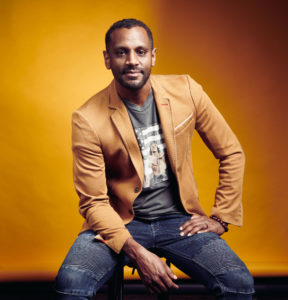Carlos Simon Brings His Compelling ‘Requiem for the Enslaved’ to San Diego
Facing the challenge of writing a Requiem, most composers think big: full orchestra, large chorus, and a quartet of vocal soloists. When Carlos Simon was moved to compose his Requiem for the Enslaved, he had a very different vision. Thursday at UC San Diego’s Mandeville Auditorium, Simon and the musical colleagues for whom he wrote his Requiem performed the West Coast premiere of his Requiem for the Enslaved.
In the storied history of Requiems, Simon’s is unique, in part because of the unusual circumstances that prompted his work. In 2017, shortly after joining the faculty of Georgetown University in Washington, D.C., Simon discovered a disturbing event in the university’s past. In 1836, the Jesuits who ran the university sold 272 enslaved African-Americans to a plantation near Baton Rouge, Louisiana, in order to bail out the school’s troubled finances.After viewing the historical documents of the university’s sale, Simon secured the support of the Georgetown University President to visit current descendants of this 1836 sale living in Louisiana to gather background for his Requiem, and during the Covid lockdown the composer found time to complete his Requiem for the Enslaved.
In place of full orchestra, Simon devised a radiant instrumental texture for a quartet of two strings and two winds filled with deft counterpoint and brilliant effects, an assignment carried out with laudable conviction and breathtaking finesse by Hub New Music: Michael Avitabile (flutes); Gleb Kanasevich (clarinets); Meg Rohrer (violin/viola), and Jesse Christeson (cello). Simon placed himself at the piano to act as the jazz-inflected continuo, and he recruited trumpeter Jared Baily to improvise boldly over his score. Simon tapped rap artist Marco Pavé as the griot—the storyteller in African traditions— to both recount and interpret the whole Georgetown story.
Although Simon followed the overall structure of the traditional Roman Catholic Requiem, like Benjamin Britten in his War Requiem, Simon added added new sections to develop the story of the people Georgetown sold in 1836. At the opening of this Requiem, we hear a long list of names of the enslaved read in solemn but hushed cadence. Allusions to spirituals weave in and out of the Requiem’s agile instrumental textures, and early in the Requiem we hear a leitmotif based on the opening phrase of the familiar spiritual “When the Saints Go Marching In.” This theme returns throughout the work, until in one of Simon’s final movements, “in paradisium,” we hear Simon’s piano and Baily’s muted trumpet offer the entire spiritual in a tranquil, soulful rendition.
Pavé and Simon have reinterpreted certain parts of the traditional Requiem text, e.g. the Kyrie eleison, the Greek words for “Lord have mercy,” becomes the insistent chant “let us go.” In the traditional Requiem, Lazarus, a minor character from the New Testament, is mentioned in passing, but in Simon’s Requiem, he lifts up one of the 272, a certain “Isaac who ran away.” Because Simon’s work is a Requiem of chamber music proportion, its intimate scale makes its telling emotional impact inescapable. Verdi depicted the dread of the Last Judgement through his Requiem’s tumultuous orchestral score, but Marco Pavé evoked the agony of the enslaved through the devastating edge of his riveting narration. Gabriel Fauré depicted the bliss of heaven with the orchestra’s entire string section in his Requiem’s “In Paradisium,” while Simon achieved an equal sense of divine fulfillment in his serene yet probing piano postlude based on the spiritual “Swing Low, Sweet Chariot.”
Trumpeter Jared Baily’s bravura flights into his highest register were equalled by flutist Michael Avitablile’s sumptuous flute sonority, the stirring depth of Gleb Kanasevich’s bass clarinet themes, as well as the eloquent focus of the well-matched string players, violinist Meg Rohrer and cellist Jesse Christeson. While Simon gave himself a few flashy flourishes, his understated but assured gospel piano style gracefully integrated the Requiem’s contrasting components.
This concert was presented by the University of California San Diego’s ArtPower on Thursday, November 9, 2023, in the university’s Mandeville Auditorium.

Ken Herman, a classically trained pianist and organist, has covered music for the San Diego Union, the Los Angeles Times’ San Diego Edition, and for sandiego.com. He has won numerous awards, including first place for Live Performance and Opera Reviews in the 2017, the 2018, and the 2019 Excellence in Journalism Awards competition held by the San Diego Press Club. A Chicago native, he came to San Diego to pursue a graduate degree and stayed.Read more…

